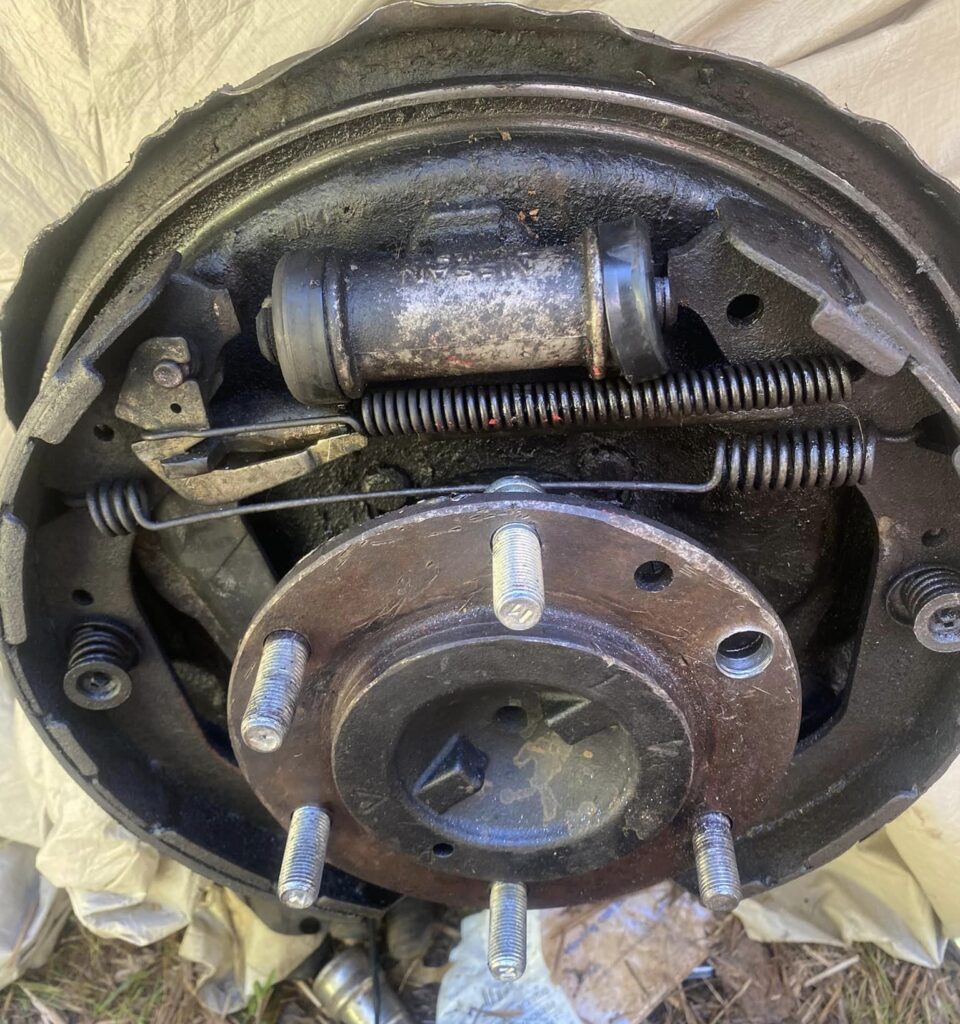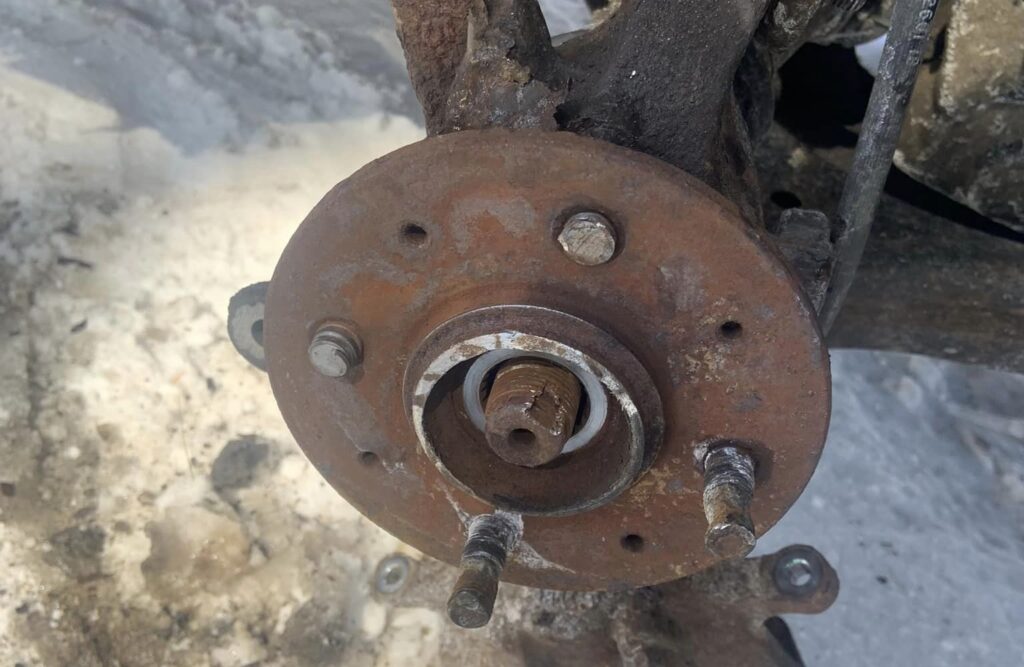Wheel studs are bolts that keep the wheels and brake assembly in place. Different types of vehicles have different numbers of wheel studs. Usually, there are four to six studs on each wheel. What happens if a wheel stud breaks? Is it safe to drive with a broken wheel stud?
Key Takeaway
- A wheel stud is a threaded metal bolt that attaches the wheel to the vehicle’s hub, allowing for secure mounting and rotation.
- It is not safe to drive with a broken wheel stud because once a stud breaks, it puts additional pressure on the remaining wheel studs, causing them to eventually break as well.
- It is dangerous to drive with a broken wheel stud because the wheel will start to wobble and could fall off and possibly cause an accident.
What Is a Wheel Stud?

A wheel stud is a threaded metal bolt-like component that is attached to the wheel hub and extends through the holes in the wheel.
It serves as a mounting point for the lug nut and helps secure the wheel to the hub.
The wheel stud provides a strong connection between the wheel and the vehicle, allowing for safe and stable driving conditions.
It is important to ensure that the wheel studs are properly installed and tightened to prevent any issues with wheel stability or detachment.
Is It Safe To Drive With a Broken Wheel Stud

No, it is not safe to drive with a broken wheel stud as it can lead to wheel instability, wobbling, and potentially cause accidents.
The wheel stud plays a crucial role in maintaining the connection between the wheel and the vehicle.
A broken wheel stud can lead to instability, wobbling of the wheel, and even potential wheel detachment while driving. It is important to replace a broken wheel stud promptly to ensure safe driving conditions.
When one or more wheel stud breaks, it puts more stress and load on the remaining wheel studs and wheel bearing. Each wheel stud is designed to hold a certain amount of pressure and load before breaking.
Over time, the remaining wheel studs and wheel bearing will give way. This will cause the wheel bearing and remaining studs to prematurely fail. A loud growling noise can be heard when the wheel bearing starts to fail.
Eventually, if the broken stud problem is not fixed soon enough, this will cause the wheel to eventually fall off and possibly cause an accident. As a safety percussion make sure you drive the vehicle at low speed to the nearest auto mechanic shop or tire shop.
Why Do Wheel Studs Break Off?
- Over-tightening of lug nuts during installation.
- Corrosion or rust buildup on the wheel stud.
- Improper torque specifications during wheel installation.
- Excessive vibration or impact on the wheel.
- Fatigue or wear and tear over time.
- Incorrect wheel stud length or improper fitment.
- The substandard quality or material of the wheel stud.
Signs of Broken Wheel Studs
- Loose or wobbling wheel.
- Vibration or shaking felt while driving.
- Noise coming from the wheel area, such as clicking or grinding sounds.
- Difficulty in tightening or loosening lug nuts.
- Missing or sheared-off lug nuts.
- Visible damage or breakage of the wheel stud.
- Wheel detachment or separation while driving (in severe cases).
- Uneven tire wear or abnormal tire pressures.
How Much Does It Cost To Replace a Wheel Stud?

An average cost of a broken wheel stud costs between $80 and $100. The parts cost no more than $20 and the rest is labor.
You can replace a wheel stud by yourself. Only replace your wheel stud if you feel confident in your mechanic skills. If you are not an experienced mechanic, take your vehicle to the repair shop.
How Bad Is It To Drive Missing a Wheel Stud?
Driving with a missing wheel stud is not recommended and can pose risks to your safety.
The missing stud can lead to wheel instability, causing the remaining lug nuts and studs to bear extra pressure and potentially fail.
This can result in the wheel becoming loose or even detachment while driving, leading to accidents.
Additionally, the imbalance created by the missing stud can cause vibrations, uneven tire wear, and damage to other vehicle parts.
Can You Drive a Car With Only 4 Lug Nuts?
Yes, you can drive a car with only 4 lug nuts. However, it is not advisable to do so for an extended period of time.
The lug nuts play a crucial role in securing the wheel to the hub, and having one missing puts additional stress on the remaining lug nuts.
This can potentially lead to loosening or failure of the remaining lug nuts, causing the wheel to detach while driving.
Therefore, it is recommended to replace any missing lug nuts as soon as possible to ensure safe driving conditions.
Can I Drive My Car With Only 2 Wheel Nuts?
It is not safe to drive a car with only 2 wheel nuts as it can put excessive stress on the remaining lug nuts and potentially lead to wheel detachment while driving.
It is important to have all lug nuts properly installed and tightened to ensure safe driving conditions. If you are missing lug nuts, it is best to have them replaced as soon as possible by a professional mechanic.
Can You Drive With 3 Out of 5 Wheel Studs?
Driving with only 3 out of 5 wheel studs is not recommended and can jeopardize your safety.
It is important to note that the missing studs put additional strain on the remaining ones. This added stress can weaken them over time and increase the risk of further failures.
How To Fix a Broken Wheel Stud?
To a broken wheel stud, you can follow these steps:
Step 1: Gather the necessary tools
You will need a lug wrench, a hammer, a new wheel stud, and a wrench or socket set.
Step 2: Loosen the lug nuts
Before lifting the vehicle, use a lug wrench to loosen the lug nuts on the wheel with the broken stud.
Step 3: Lift the vehicle
Use a jack to lift the vehicle off the ground and secure it with jack stands.
Step 4: Remove the wheel
Once the vehicle is lifted and secured, remove the lug nuts and take off the wheel.
Step 5: Remove the broken stud
Locate the broken stud and use a hammer to pound it out from the back of the hub. If it is rusted or stuck, you may need to use penetrating oil and a punch to loosen it.
Step 6: Install the new stud
Take the new wheel stud and insert it into the hole where the old one was. Make sure it is properly aligned.
Step 7: Tighten the new stud
Place a few washers over the threaded end of the new stud, then screw on a lug nut. Use a wrench or socket set to tighten the lug nut, pulling the stud all the way through until it is fully seated.
Step 8: Replace the wheel and lug nuts
Put the wheel back on the hub and hand-tighten the lug nuts. Lower the vehicle from the jack stands and use the lug wrench to fully tighten the lug nuts in a star pattern.
Step 9: Check for proper installation
After tightening the lug nuts, double-check that the wheel is securely attached and there is no wobbling.
FAQs
Q: What causes a wheel stud to break?
A: There can be several causes for a wheel stud to break, such as over-tightening, excessive force, rust, corrosion, or improper installation.
Q: Can I drive with a missing lug nut?
A: It is not recommended to drive with a missing lug nut. The lug nuts help secure the wheel onto the wheel hub, and a missing lug nut can cause the wheel to wobble or even come off while driving.
Q: Can I replace a broken wheel stud myself?
A: If you have the necessary tools and experience, you can replace a broken wheel stud yourself. However, it is recommended to have a mechanic or professional handle this task to ensure proper installation and safety.
Q: How do I replace a broken wheel stud?
A: To replace a broken wheel stud, you will need to remove the wheel, brake caliper, and rotor (if necessary). Then, you can remove the broken stud, insert a new stud, and tighten it using a torque wrench.
Q: Can a broken wheel stud damage the wheel hub?
A: Yes, a broken wheel stud can potentially damage the wheel hub if not addressed promptly. The damaged stud can create stress on the hub, leading to further issues with the wheel bearings or other components.
Q: Should I replace all the wheel lug studs if one breaks?
A: It is not necessary to replace all the wheel lug studs if one breaks. However, it is a good practice to inspect the remaining studs for any signs of damage or wear and replace any that are found to be compromised.
Q: How can I prevent wheel studs from breaking?
A: To prevent wheel studs from breaking, it is important to ensure proper torquing during installation. Using a torque wrench to tighten the lug nuts to the manufacturer’s specifications can help prevent over-tightening and potential damage to the studs.
Q: Can I drive my car with a broken lug nut?
A: It is not recommended to drive your car with a broken lug nut. The lug nuts provide essential stability and security for the wheel, and a broken lug nut can compromise the overall safety of the vehicle.
Q: Where can I find a replacement wheel stud?
A: You can find a replacement wheel stud at an auto parts store or through your local mechanic. They will be able to provide you with the appropriate stud for your specific vehicle make and model.
In Conclusion
The safety of driving with a broken wheel stud depends on the severity of the issue. If there is significant damage to the wheel, then it is not safe to drive until it has been replaced or repaired.
On the other hand, if only one stud is broken and the rest are in good working order, you should be able to drive your vehicle as usual, but it’s important to keep an eye on the wheel and make sure that it doesn’t get worse.
